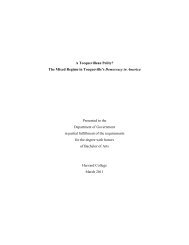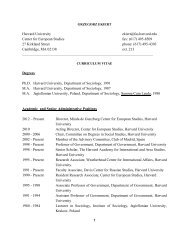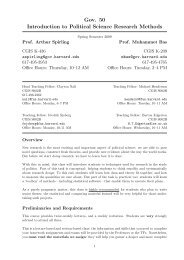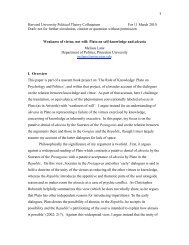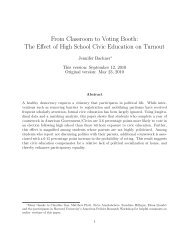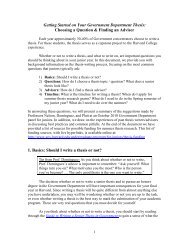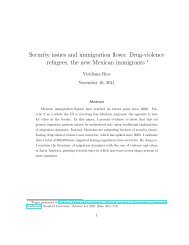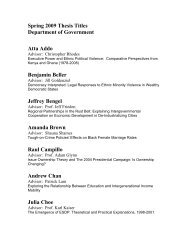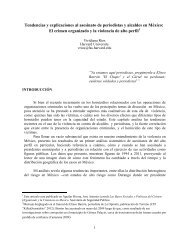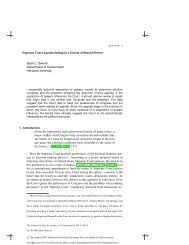Why did Mexico become so violent? - Department of Government ...
Why did Mexico become so violent? - Department of Government ...
Why did Mexico become so violent? - Department of Government ...
Create successful ePaper yourself
Turn your PDF publications into a flip-book with our unique Google optimized e-Paper software.
Author's per<strong>so</strong>nal copy<br />
Trends Organ Crim (2013) 16:138–155 149<br />
Fig. 5 Competition and Michoacán violence. Source CSN 2010; Rios 2012a<br />
Guanajuato<br />
The effects <strong>of</strong> drug-related violence due to the competition between Los Zetas and La<br />
Familia were al<strong>so</strong> felt in other states, particularly Guanajuato. Until late 2008<br />
trafficking within the state was controlled by a stable alliance between the Sinaloa<br />
Cartel and La Familia. Back then, the average number <strong>of</strong> drug-related executions in<br />
the state was about 4.5 per month. In 2007 the state only suffered 51 cases <strong>of</strong> drugviolence<br />
and in 2008 only 79. Without any <strong>so</strong>urce <strong>of</strong> confrontation between La<br />
Familia and the Sinaloa Cartel or between other drug trafficking organizations,<br />
Guanajuato was literally as peaceful as Honolulu. Guanajuato’s general homicide<br />
rate was about 2.39 per 100,000 inhabitants, quite impressive for one <strong>of</strong> the most<br />
urban states in the country.<br />
The peace was shattered when the hostilities between La Familia and Los Zetas<br />
spread into the state. The first record <strong>of</strong> Los Zetas operating in the state happened in<br />
November 2008 when a narco-message blaming an ex-federal policeman for supporting<br />
them was left in Irapuato, Guanajuato. Narco-messages <strong>so</strong>on inundated the state,<br />
<strong>so</strong>me <strong>of</strong> them explicitly linking drug-related violence to the conflict between La<br />
Familia and Los Zetas. In Celaya, for example, a message signed by Los Zetas was<br />
left next to a body declaring “these are people <strong>of</strong> La Familia, kidnappers, extorters,<br />
and terrorist apprentices.” Others just warned the population about what Los Zetas<br />
claimed to be the ultimate rea<strong>so</strong>ns for the confrontation: “[We] condemn the crystal<br />
and ice poi<strong>so</strong>ners [i.e. drug dealers] belonging to La Familia, we are just taking out<br />
the trash.” By January 2009, the open confrontation between La Familia and Los<br />
Zetas had turned Guanajuato upside down. In 2009, there were 234 drug-related<br />
homicides, an increase <strong>of</strong> 196 % in compari<strong>so</strong>n to 2008. Violence spiked during the<br />
first semester <strong>of</strong> 2009, when an average <strong>of</strong> 19.75 drug-related homicides per month<br />
became the rule.<br />
As Fig. 6 shows, drug-related violence in Guanajuato tends to be higher when<br />
many trafficking organizations operate and compete in a single municipality. A<br />
competitive month has an average on 17.4 drug-related homicides, while a month<br />
without competition has only 7.3. As a matter <strong>of</strong> fact, when Los Zetas confronted La<br />
Familia, Guanajuato was unrecognizable in terms <strong>of</strong> drug violence. In 2009 it joined<br />
the list <strong>of</strong> the top-ten most <strong>violent</strong> states for the first time ever. As Mrs. Berta, a food<br />
vendor <strong>of</strong> Cuerámaro, a border town between Michoacán and Guanajuato, confessed<br />
to Verónica Espinoza, a journalist <strong>of</strong> Proce<strong>so</strong> magazine, “We have no peace. Now,<br />
with all the homicides… God! You realize people suddenly start having money and



